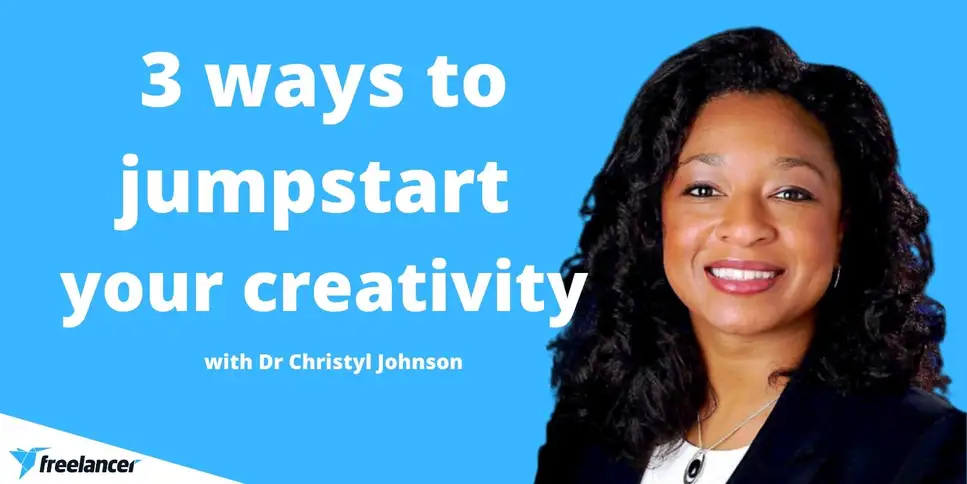Chatea con Ava - Tu consultor de negocios IA
¡Hola, soy Ava, tu guía de IA para potenciar tu negocio!
Ya sea que dirijas una empresa o sueñes con iniciar una, estoy aquí para hacer realidad tu visión gracias a los freelancers que usan IA. Comparte los objetivos de tu negocio y juntos crearemos un proyecto en los que nuestros talentosos freelancers puedan ofertar. ¡Hagamos realidad tu visión!
Tengo un negocio
Estoy comenzando un negocio
Algo salió mal al enviar la conversación a tu correo electrónico. Por favor, intenta de nuevo más tarde.
Solo puedes guardar tu conversación una vez por hora. Por favor, intenta de nuevo más tarde.
Tu conversación es demasiado corta. Sigue chateando con Ava para poder guardar.
Dr Christyl Johnson: 3 Ways to Jumpstart Your Creativity
If your creativity needs a jump start follow Dr Christyl Johnson's tips to get back on track fast
2 dic 2019 • Lectura de 4 minutos
Actualizado el 9 dic 2019 por Closed User
E
Closed User
Falló el copiado al portapapeles. Intenta de nuevo después de ajustar tus permisos.
Copiado al portapapeles.

Dr Christyl Johnson shares her creativity tips
Is there anything more frustrating than hitting a creative roadblock?
You know the results you need but you cannot seem to cross the mental chasm to get there.
We had the privilege of speaking to Dr. Christyl Johnson, NASA's deputy director for technology and research investments, to discuss her framework for cultivating creativity.
1. Peel open your mind: Brainstorm
The first step is assembling the people directly involved in solving the problem (the think tank) to flesh out everyone's ideas into a draft document. Writing these ideas out by hand is more beneficial than typing, because it stimulates large portions of the brain involved in language, memory and critical thinking.
This collaborative brainstorming session will encourage the continuous flow of information out of your mind and may also inspire fellow think tank members with new creative ideas.
"I tell everybody to get their think tank together and get all your ideas fleshed out into a draft document," Dr. Johnson says.
2. Gather suggestions from outside experts
This next step may be a little challenging to those who are reluctant to share their early stage ideas, but it's extremely effective. Dr. Johnson suggests taking your draft document of ideas and showing it to an expert outside your field to gather their unique insights.
"Have somebody take a look at it who is not accustomed to doing what you guys are doing. Somebody in a totally different field," she says.
The benefit of appealing to outsiders is that they're not bound to the standard solutions in your industry. They're free to approach the problem from a unique perspective and provide some fantastic insights.
According to a Harvard Business Review study , the further the advice is from the context of your problem, the more novel their ideas are:

Ideally, you should seek the insight of reputable minds. "Somebody who has expertise,but is maybe using that expertise for a totally different application," Dr. Johnson says.
This is because they're trained to think critically and will approach your problem statement from a unique perspective of intelligence.
According to Dr. Johnson, some of your most creative ideas could be generated by doing this.
"And that's when you really start to get those creative juices flowing. Even if it isn't someone who has a similar expertise, just outside thinkers will ask you questions that make you think, and you need that."
Not everybody's advice will be beneficial. Even experts get things wrong at times.
But how do you identify and disregard bad advice? Filtering out bad advice that could be detrimental to your project is difficult. According to Dr. Johnson, this is where your years of experience should be factored into the equation.
"That is really going to take some seasoning" she says. "For me, that involves laying out all of the information and going through the pros and the cons of whatever the person is recommending. At the end, it's my gut feel, because I've got years of experience to help me make such judgement calls."
But, if you lack years of experience, what do you do?
In these situations, Dr. Johnson suggests appealing to those you know you can trust.
"If you don't have years of experience, it's going to take real thinking and getting with someone that you can trust, in terms of their judgment, to help you navigate through those waters."
Trustworthy experts could be buried in a separate team in your workplace, a family member or college friend. But if you're strapped for options, LinkedIn is a great platform to use, because you can see a summary of everyone's level of expertise on their profile.
3. Take a walk
Dr. Johnson's final piece of advice is an ancient technique which was a particular favorite for Steve Jobs : the simple art of walking.
If you're feeling stuck, separating yourself from your work will calm your mind and put it in the optimal state for creativity.
"A totally different environment tricks your brain into thinking that you're in a relaxed state which kind of really helps with creativity," Dr. Johnson says.
According to Dr. Johnson, this activity isn't necessarily performed solo. She and her team often go on mini "creativity excursions" with their workbooks in hand to note down creative solutions as they unexpectedly spring to life.
"We would go to the mall," she says. "Or, we would go out on a boat and be on the water, and still bring our stuff with us."
So, if you and your team are struggling to solve a complex problem, simply take your notepads and go for a walk together.
Dr Johnson's creativity framework can be implemented by anyone. If you integrate this practice of actively pursuing creativity into your workplace culture, imagine the creative solutions your business will come up with.
Historias relacionadas
Habla con uno de nuestros Copilotos técnicos para que te ayude con tu proyecto
Artículos recomendados solo para ti

How to hire a freelance writer and build an effective content marketing strategy. Content is your most profitable marketing investment, make it count.
12 min read

Got a great idea for an app? Need a new way to grow your business? We tell you everything you need to know about building a mobile app in 2020.
16 min read

Not all mobile apps are crowned with the glory of success, some fail miserably. Avoid failure by learning from the top 5 mobile app failures.
8 min read

Not every graphic designer can pull off a great logo design. Follow these 6 tips to ensure your logo sparkles and clients keeps coming back for more.
6 min read
¡Gracias! Te hemos enviado un enlace para reclamar tu crédito gratuito.
Algo salió mal al enviar tu correo electrónico. Por favor, intenta de nuevo.
Cargando visualización previa
Permiso concedido para Geolocalización.
Tu sesión de acceso ha expirado y has sido desconectado. Por favor, inica sesión nuevamente.






















